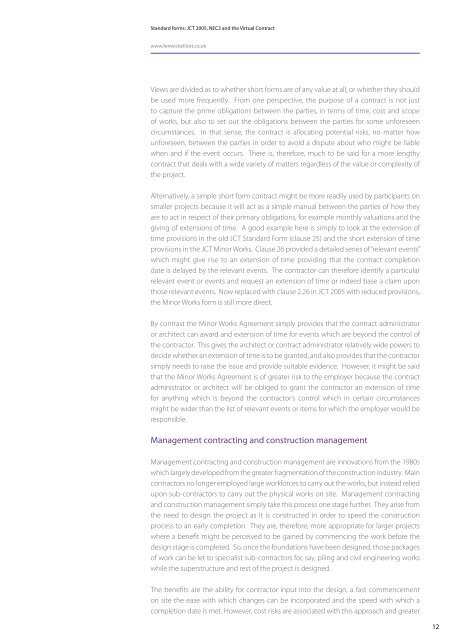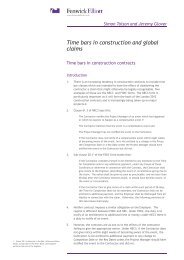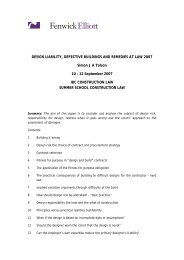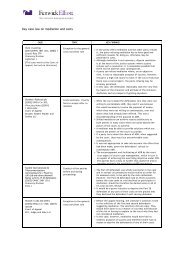Standard forms: JCT 2005, NEC3 and the Virtual ... - Fenwick Elliott
Standard forms: JCT 2005, NEC3 and the Virtual ... - Fenwick Elliott
Standard forms: JCT 2005, NEC3 and the Virtual ... - Fenwick Elliott
Create successful ePaper yourself
Turn your PDF publications into a flip-book with our unique Google optimized e-Paper software.
<strong>St<strong>and</strong>ard</strong> <strong>forms</strong>: <strong>JCT</strong> <strong>2005</strong>, <strong>NEC3</strong> <strong>and</strong> <strong>the</strong> <strong>Virtual</strong> Contract<br />
www.fenwickelliott.co.uk<br />
Views are divided as to whe<strong>the</strong>r short <strong>forms</strong> are of any value at all, or whe<strong>the</strong>r <strong>the</strong>y should<br />
be used more frequently. From one perspective, <strong>the</strong> purpose of a contract is not just<br />
to capture <strong>the</strong> prime obligations between <strong>the</strong> parties, in terms of time, cost <strong>and</strong> scope<br />
of works, but also to set out <strong>the</strong> obligations between <strong>the</strong> parties for some unforeseen<br />
circumstances. In that sense, <strong>the</strong> contract is allocating potential risks, no matter how<br />
unforeseen, between <strong>the</strong> parties in order to avoid a dispute about who might be liable<br />
when <strong>and</strong> if <strong>the</strong> event occurs. There is, <strong>the</strong>refore, much to be said for a more lengthy<br />
contract that deals with a wide variety of matters regardless of <strong>the</strong> value or complexity of<br />
<strong>the</strong> project.<br />
Alternatively, a simple short form contract might be more readily used by participants on<br />
smaller projects because it will act as a simple manual between <strong>the</strong> parties of how <strong>the</strong>y<br />
are to act in respect of <strong>the</strong>ir primary obligations, for example monthly valuations <strong>and</strong> <strong>the</strong><br />
giving of extensions of time. A good example here is simply to look at <strong>the</strong> extension of<br />
time provisions in <strong>the</strong> old <strong>JCT</strong> <strong>St<strong>and</strong>ard</strong> Form (clause 25) <strong>and</strong> <strong>the</strong> short extension of time<br />
provisions in <strong>the</strong> <strong>JCT</strong> Minor Works. Clause 26 provided a detailed series of “relevant events”<br />
which might give rise to an extension of time providing that <strong>the</strong> contract completion<br />
date is delayed by <strong>the</strong> relevant events. The contractor can <strong>the</strong>refore identify a particular<br />
relevant event or events <strong>and</strong> request an extension of time or indeed base a claim upon<br />
those relevant events. Now replaced with clause 2.26 in <strong>JCT</strong> <strong>2005</strong> with reduced provisions,<br />
<strong>the</strong> Minor Works form is still more direct.<br />
By contrast <strong>the</strong> Minor Works Agreement simply provides that <strong>the</strong> contract administrator<br />
or architect can award <strong>and</strong> extension of time for events which are beyond <strong>the</strong> control of<br />
<strong>the</strong> contractor. This gives <strong>the</strong> architect or contract administrator relatively wide powers to<br />
decide whe<strong>the</strong>r an extension of time is to be granted, <strong>and</strong> also provides that <strong>the</strong> contractor<br />
simply needs to raise <strong>the</strong> issue <strong>and</strong> provide suitable evidence. However, it might be said<br />
that <strong>the</strong> Minor Works Agreement is of greater risk to <strong>the</strong> employer because <strong>the</strong> contract<br />
administrator or architect will be obliged to grant <strong>the</strong> contractor an extension of time<br />
for anything which is beyond <strong>the</strong> contractor’s control which in certain circumstances<br />
might be wider than <strong>the</strong> list of relevant events or items for which <strong>the</strong> employer would be<br />
responsible.<br />
Management contracting <strong>and</strong> construction management<br />
Management contracting <strong>and</strong> construction management are innovations from <strong>the</strong> 1980s<br />
which largely developed from <strong>the</strong> greater fragmentation of <strong>the</strong> construction industry. Main<br />
contractors no longer employed large workforces to carry out <strong>the</strong> works, but instead relied<br />
upon sub-contractors to carry out <strong>the</strong> physical works on site. Management contracting<br />
<strong>and</strong> construction management simply take this process one stage fur<strong>the</strong>r. They arise from<br />
<strong>the</strong> need to design <strong>the</strong> project as it is constructed in order to speed <strong>the</strong> construction<br />
process to an early completion. They are, <strong>the</strong>refore, more appropriate for larger projects<br />
where a benefit might be perceived to be gained by commencing <strong>the</strong> work before <strong>the</strong><br />
design stage is completed. So, once <strong>the</strong> foundations have been designed, those packages<br />
of work can be let to specialist sub-contractors for, say, piling <strong>and</strong> civil engineering works<br />
while <strong>the</strong> superstructure <strong>and</strong> rest of <strong>the</strong> project is designed.<br />
The benefits are <strong>the</strong> ability for contractor input into <strong>the</strong> design, a fast commencement<br />
on site <strong>the</strong> ease with which changes can be incorporated <strong>and</strong> <strong>the</strong> speed with which a<br />
completion date is met. However, cost risks are associated with this approach <strong>and</strong> greater<br />
12

















